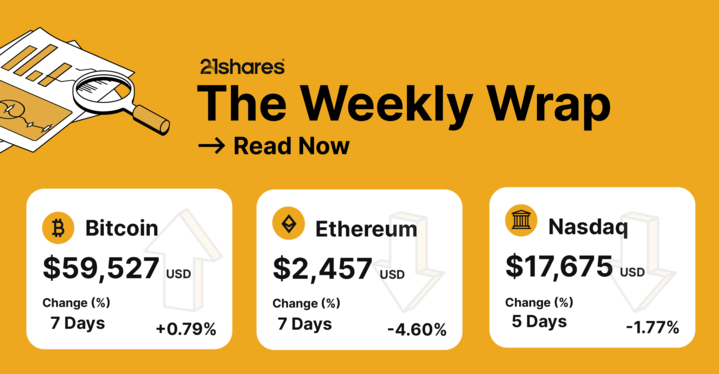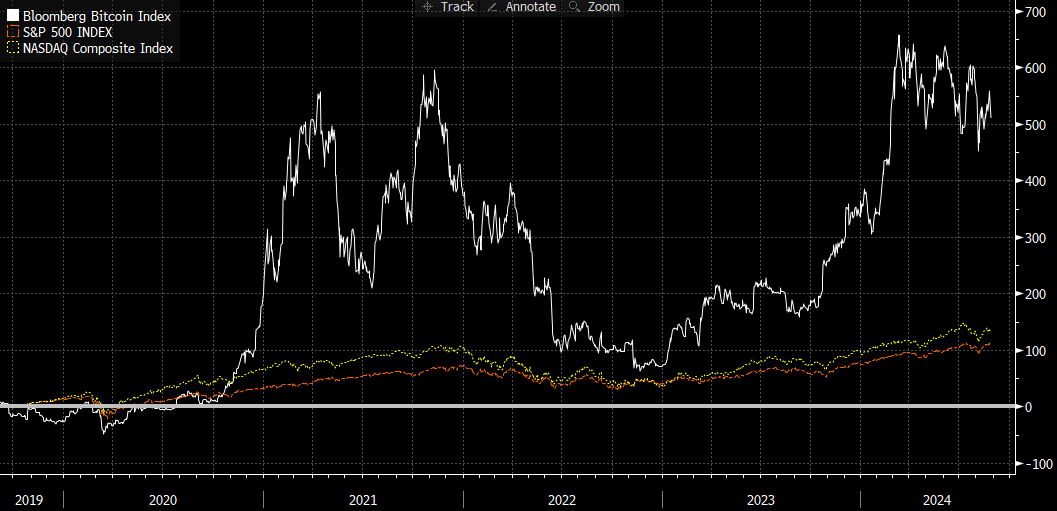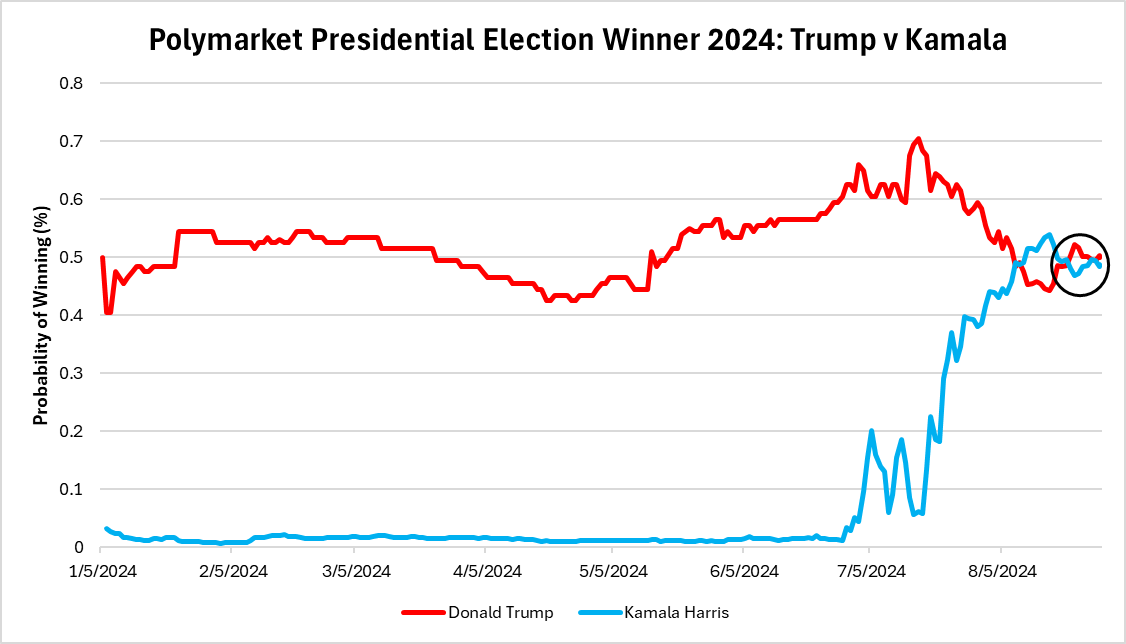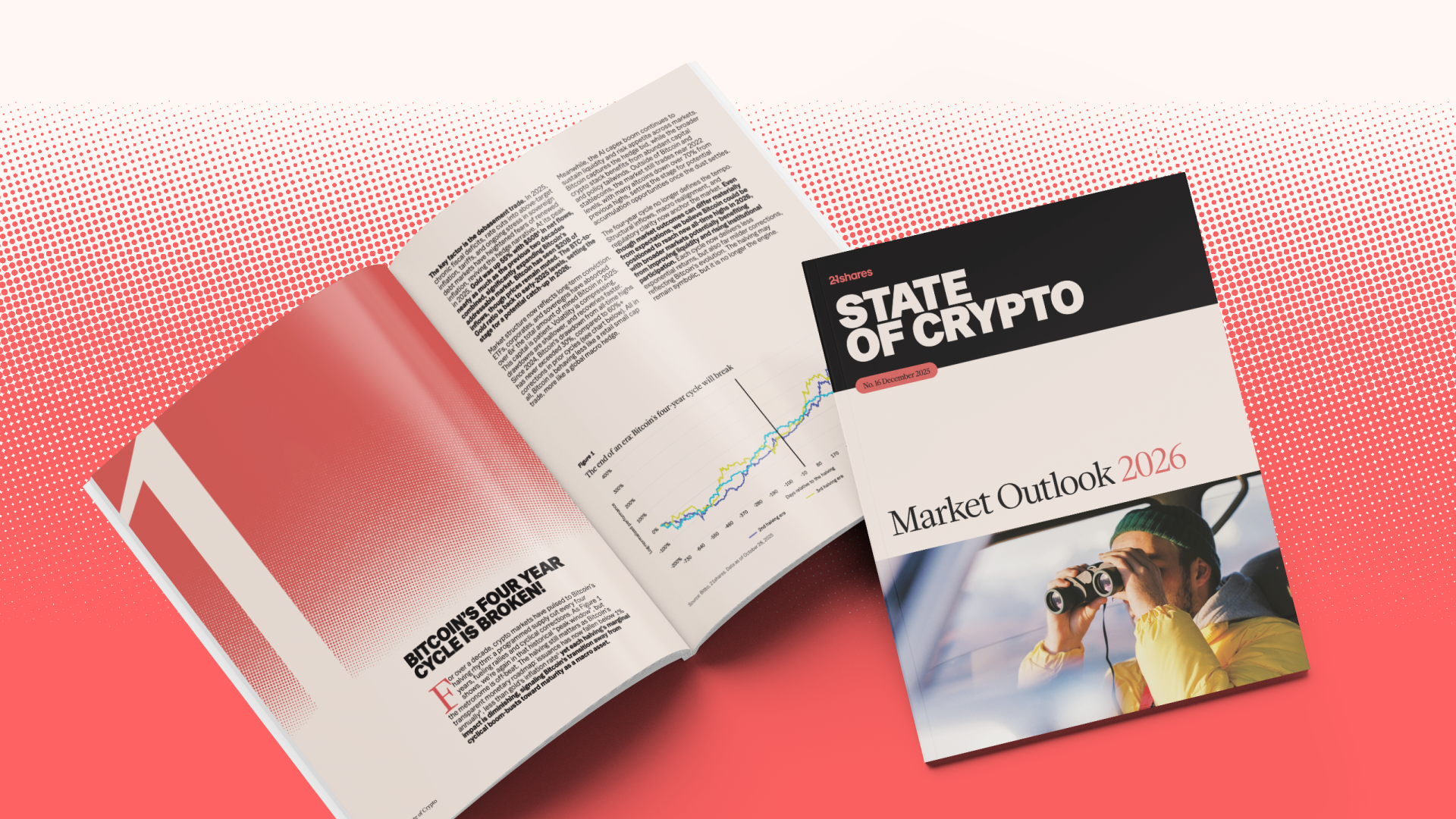Crypto Shake-Up: Fed Pivot Signals, RFK Jr. Exits, Stablecoins Soar, and Marathon’s Bold $300M Bitcoin Play
.png)



Crypto Shake-Up: Fed Pivot Signals, RFK Jr. Exits, Stablecoins Soar, and Marathon’s Bold $300M Bitcoin Play
This Week in Crypto
- Fed Pivot on the Horizon: Key Takeaways from Powell's Jackson Hole Address
- RFK Jr. Exits the Race, Endorses Trump: What This Could Mean for Digital Assets
- Stablecoin Market Cap Breaks All Time High
Fed Pivot on the Horizon: Key Takeaways from Powell's Jackson Hole Address
This past Friday, Federal Reserve Chair Jerome Powell delivered his much-anticipated speech at the Jackson Hole economic conference, signaling that the Fed is ready to begin cutting interest rates, with the first reduction likely to occur in September. Powell expressed confidence that inflation is on track to reach the Fed's 2% target and noted a significant slowdown in the labor market. He emphasized that the Fed would not tolerate further weakening in the job market and indicated that the timing and size of rate cuts would be determined by incoming data.
Powell's remarks suggest a shift in the Fed's focus from solely combating inflation to also preventing job losses, especially with the U.S. presidential election on the horizon. While markets continue to anticipate a 25 basis point cut, with the CME FedWatch tool showing a 65.5% likelihood of this move, the probability of a 50 basis point cut has risen to 34.5%, up from 24% just a day before Powell’s speech. Key economic reports, including August's employment and inflation data, will be crucial in shaping the Fed's final decision in September. Powell's speech also had a notable impact on global markets, leading to gains in U.S. stocks, a drop in Treasury yields, a weakening of the dollar, and a roughly 3% increase in the prices of both BTC and ETH. So this leads to the ultimate question: what does this mean for digital assets and other risk assets?
Lower interest rates increase liquidity in the financial system and foster a more risk-on environment as borrowing becomes cheaper, encouraging investors to seek higher returns in riskier assets, such as digital assets. This influx of liquidity often flows into various asset classes, particularly digital assets like Bitcoin. When yields on traditional fixed-income instruments, such as treasuries and corporate bonds, decline, investors' appetite for risk grows, prompting them to deploy capital into assets that offer greater potential returns. Due to their 24/7/365 trading and high sensitivity to macroeconomic shifts, digital assets often lead the charge in capitalizing on these liquidity increases, front-running investments into other risk assets.
During the COVID-19 crash in March 2020, Bitcoin was the quickest major asset to recover, rebounding to pre-crash levels within two months—outpacing the S&P 500, which took four months, and the NASDAQ Composite Index, which took three months. This rapid recovery highlighted Bitcoin's role as a leading indicator, with liquidity entering the digital asset market well before traditional markets. Over the nine months from its March 2020 bottom to early 2021, the total market cap of digital assets surged over 600%, far outpacing the recovery of other asset classes.
Figure 1: Returns (%) - BTC v S&P v NASDAQ

Source: Bloomberg Terminal, Data as of 8/27/24
Rate cuts typically weaken the U.S. dollar, as was clearly demonstrated recently when the DXY, an index measuring the dollar's value against a basket of foreign currencies, dropped roughly 1% following Powell's hint at future rate cuts. Bitcoin, often viewed as a hedge against the U.S. dollar, tends to attract inflows when the dollar weakens, leading to an inverse correlation (-0.244) with the DXY. As a result, lower rates, which weaken the dollar, often drive investors toward Bitcoin, enhancing its appeal as a hedge against a depreciating dollar.
Overall, a Fed rate cut typically creates a favorable environment for risk assets, such as Bitcoin and Ethereum, by lowering the cost of capital, increasing liquidity, and boosting investor sentiment to a more risk-on sentiment. These factors can drive increased demand for digital assets, pushing up prices and expanding the network effect of the digital asset space.
So is the Fed rate cut the only bullish narrative for digital assets?
RFK Jr. Exits the Race, Endorses Trump: What This Could Mean for Digital Assets
Robert F. Kennedy Jr., a strong advocate for digital assets with the majority of his eight-figure net worth held in Bitcoin, has suspended his independent presidential campaign and urged his supporters to back former President Donald Trump in key battleground states, effectively lending the Kennedy name to the GOP candidate. Kennedy decided to withdraw from the ballot in 10 battleground states, states that are crucial to the Trump campaign. In return for his support, Kennedy is expected to join a potential Trump administration. This move shifts the election focus more clearly to the two major party candidates, with Vice President Kamala Harris currently holding a slight edge over Trump in national polls. Rumors of Kennedy bowing out began circulating early last week and were confirmed on Friday, August 23, 2024. The announcement initially boosted Trump's odds of winning on Polymarket from 48% at the start of the week to 52% on the day of the announcement, before settling at a narrow 50% lead over Harris's 49%. Trump has recently embraced digital assets, delivering the keynote address at the 2024 Bitcoin Conference last month and launching his fourth series of digital trading card NFTs.
Figure 2: Polymarket Election Winner, Trump v Kamala

Source: Polymarket, Data as of 8/27/24
Robert F. Kennedy Jr.'s decision to suspend his independent presidential campaign and endorse Donald Trump in battleground states could have several effects on the crypto markets, as it increases Trump’s odds of victory:
Relieved Selling Pressure: Former President Trump has pledged to hodl the US’s 200,000 bitcoin holdings as part of a new strategic stockpile, aligning with a growing group of Bitcoin-friendly lawmakers led by U.S. Senator Cynthia Lummis. This would remove 200,000 bitcoin of selling pressure, roughly $12 billion at today’s prices, from the market. For context, the recent sale of 50,000 Bitcoin by the German government had a significant impact, causing Bitcoin's price to tumble from $70,000 to $55,000. By committing to hold this Bitcoin, the U.S. government would not only demonstrate strong confidence in the asset's long-term value but also alleviate billions of dollars in potential sell pressure, which could help stabilize and support the market. This action could further boost investor confidence, enhancing the overall risk appetite for digital assets in the U.S.
Regulatory Environment: Trump has shown increasing support for digital assets, which could lead to a more favorable regulatory environment for digital assets. This might include clearer regulations, reduced barriers to entry, and a more supportive stance from government agencies, potentially encouraging growth and innovation in the crypto space. Trump has pledged to remove Gary Gensler as the SEC chair, a move that could significantly enhance the regulatory environment for digital assets in the U.S. and enhance investor sentiment for digital assets.
Market Sentiment: A pro-crypto administration could boost market sentiment, leading to increased investor confidence and higher demand for digital assets. The expectation of a favorable policy landscape could drive more capital into the digital asset market, pushing prices higher and encouraging a greater appetite for risk among investors who see potential for substantial returns.
Increased Adoption: With a president who has embraced digital assets, there could be a push for broader adoption of digital assets and blockchain technology across various sectors, including finance, government, and technology.
Institutional Involvement: A Trump presidency might encourage more institutional investors to enter the crypto space, particularly if there are clear regulatory guidelines and a supportive government stance. This could lead to greater liquidity, higher trading volumes, and increased market maturity.
Global Implications: A Trump victory could influence global attitudes towards cryptocurrencies. If the U.S. under Trump becomes more crypto-friendly, other nations might follow suit or, conversely, tighten their own regulations in response, depending on their stance towards U.S. policies.
In conclusion, Robert F. Kennedy Jr.'s decision to suspend his independent presidential campaign and endorse Donald Trump in key battleground states is a significant move that could have far-reaching implications, particularly for the crypto markets and the overall risk appetite for digital assets in the U.S. With Trump’s increased odds of victory, the potential for a more favorable regulatory environment, reduced selling pressure on Bitcoin, and a government stance supportive of digital assets could greatly benefit the digital asset space. This shift could lead to greater market confidence, higher prices, and a broader adoption of digital assets and blockchain technology. Additionally, Trump's commitment to holding the U.S.'s Bitcoin reserves and removing regulatory barriers could attract more institutional investors, driving market maturity and liquidity. On a global scale, the Trump administration's pro-crypto policies might influence other nations' approaches to digital assets, further solidifying the role of digital assets in the global financial landscape and enhancing the overall risk appetite for these assets. As the appetite for digital assets and risk grows, so does the issuance of stablecoins.
Stablecoin Market Cap Breaks All Time High
The total stablecoin market capitalization, excluding algorithmic stablecoins, reached a new all-time high over the weekend, surpassing $168.1 billion, according to DefiLlama data. This marks a 0.8% increase over the past week and exceeds the previous peak of $167 billion in March 2022. The stablecoin market cap had dipped to a low of $122 billion in October 2022 but has been steadily growing since the start of 2024.
Figure 3: Stablecoin Market Cap Excluding Algorithmic Stablecoins

Source: Defillama, Data as of 8/27/24
This rise in stablecoin market capitalization is seen as a sign that more money is flowing into the crypto market. Stablecoins, known for their stability in uncertain market conditions, are increasingly being used by institutions as a bridge between traditional finance (TradFi) and the crypto space. The growing confidence in the crypto market, especially from institutional players, is driving demand for stablecoins, which in turn can lead to higher prices in the broader crypto market.
As the stablecoin market cap increases, the altcoin market cap often follows suit. Figure 4 illustrates this, showing how the altcoin and stablecoin market caps frequently move in tandem. This connection exists because as stablecoins like USDT and USDC expand in market cap, they inject additional liquidity into the crypto ecosystem, facilitating smoother transitions for investors entering and exiting positions. This enhanced liquidity typically drives up the prices of other digital assets, as more capital becomes available to flow into various digital assets. Notably, USDT, the largest stablecoin, has seen its market cap grow by approximately 28% this year, now comprising about 70% of the total stablecoin market capitalization. In conclusion, the stablecoin market cap has reached a new all-time high of $168.1 billion, reflecting increased capital inflow into the crypto market. This growth highlights the crucial role of stablecoins as a bridge between traditional finance and digital assets, driven by institutional confidence. As stablecoins like USDT expand, they inject liquidity into the crypto ecosystem, often leading to rising altcoin prices and broader market gains.
Figure 4: Stablecoin Market Cap vs Altcoin Market Cap

Source: Coingecko and Yahoo Finance
Market Sentiment Gauge: Fear and Greed Index
A quick look at the Fear & Greed Index, a multifactorial crypto market sentiment analysis tool, indicates that the market is currently fearful.
Figure 5: Crypto Market Fear & Greed Index

Source: Alternative.me
The information provided does not constitute a prospectus or other offering material and does not contain or constitute an offer to sell or a solicitation of any offer to buy securities in any jurisdiction. Some of the information published herein may contain forward-looking statements. Readers are cautioned that any such forward-looking statements are not guarantees of future performance and involve risks and uncertainties and that actual results may differ materially from those in the forward-looking statements as a result of various factors. The information contained herein may not be considered as economic, legal, tax or other advice and users are cautioned to base investment decisions or other decisions solely on the content hereof. All content provided by 21Shares is intended for informational and educational purposes only and should not be considered investment advice or a recommendation to buy, sell, or hold any particular security. Investments associated with crypto assets, such as cryptocurrencies and crypto tokens, involve risk. These assets are considered highly speculative due to their limited history and new technological nature. Future regulatory actions may impact the usability and tradability of crypto assets. The price of crypto assets can be influenced by a small number of holders and may decline in popularity or acceptance, affecting their value. For full disclosures, please visit our Disclaimers and Terms &Conditions pages.

.jpg)









.svg)



_logo.svg)

.svg.png)